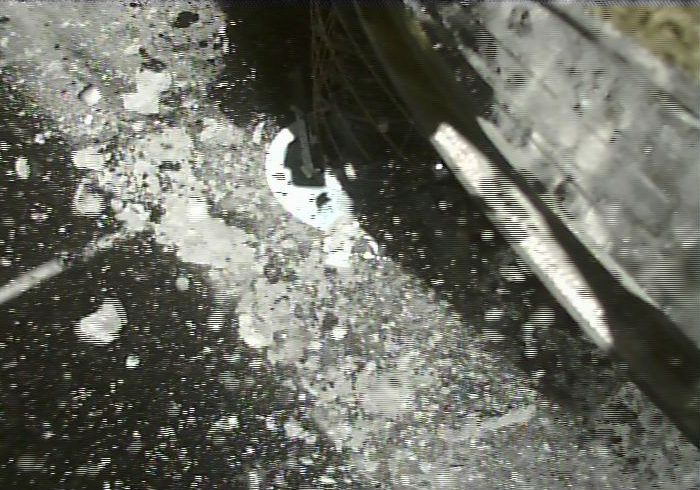How Japan's Hayabusa2 Stuck Its Landings on the Boulder-Strewn Asteroid Ryugu

WASHINGTON — "We made it!"
As footage of the Hayabusa2 spacecraft landing on asteroid Ryugu earlier this year played for delegates attending the International Astronautical Congress here last week, mission project manager Yuichi Tsuda interrupted an otherwise technical presentation to express excitement.
And why not? Despite encountering a rockier surface than expected, the Hayabusa2 mission made two flawless touchdowns on Ryugu. The successes let the spacecraft gather precious materials to bring back to Earth. Two hopping rovers and a lander deployed perfectly, and a third rover was deployed this fall. After18 months of operations at Ryugu, engineers have learned more about how to operate all sorts of spacecraft on a small world.
Related: Look Out Below! Japan's Hayabusa2 Drops Target Markers on Asteroid Ryugu
What about a follow-up mission? "There's no Hayabusa3 at this moment, but maybe in the future," Tsuda told the IAC delegates. But the Japan Aerospace Exploration Agency (JAXA) does have other missions in the works. For example, the Martian Moons eXploration (MMX) mission is expected to explore Phobos and Deimos in the early 2020s. Just like Hayabusa2, this future mission will carry back samples from the moons for detailed laboratory analysis on Earth.
Interplanetary history lesson
Hayabusa2 was designed to broaden scientists' understanding of the early solar system, when the neighborhood was made up of small worlds such as Ryugu. By studying what these worlds are made of, we can better understand Earth's history and answer such questions as where our planet's water came from, or how organic materials and other life-friendly elements ended up on our planet.
But Ryugu, covered in boulders, turned out to be a considerable challenge for scientists. The largest rock, near the south pole, is nearly 430 feet (130 meters) across. That's a huge boulder given that Ryugu itself is less than 3,000 feet (900 m) in diameter. Tsuda described the asteroid's terrain as "very severe," with a surface so rocky that scientists had to devise a new plan to safely land Hayabusa2, which was designed with a flat target area 165 feet (50 m) across in mind.
Get the Space.com Newsletter
Breaking space news, the latest updates on rocket launches, skywatching events and more!
"There were no such places on the asteroid," Tsuda said. "We were obliged to change our strategy and find a safe way, and also at the same time improve our landing performance."
Hayabusa2 engineers dropped a target marker to help the spacecraft see the white spot. The spot was so small in the pictures sent back from Ryugu that during its second descent, for example, JAXA decided to start Hayabusa2's final approach at about 100 feet (30 m), instead of the planned 150 feet (45 m), according to the Planetary Society. Mission engineers thought the lower altitude would help the spacecraft spot the marker. With the aid of more advanced image-rendering algorithms that made the surface appear clearer to Hayabusa2, the plan worked.
After making the first touchdown on Feb. 21 within 3 feet (1 m) of the small landing zone, Hayabusa2's second touchdown July 11 handily beat the mark. It gently touched the surface at an incredible 2 feet (60 centimeters) from the planned landing zone, allowing the small spacecraft to safely squeeze between several rocks that were 1.5 feet (0.5 meters) tall. "There were many fragments," Tsuda said, pointing to video footage that showed pieces of regolith flying off Ryugu's surface.
In addition to the fine-tuned landing, some of Hayabusa2's notable achievements include touching down on the surface multiple times, forming an artificial crater by firing a "bullet" into the surface, and scooping up a little subsurface material exposed by that process.
This work was achieved through years of hard work by the Hayabusa2 team, systems engineer Yuto Takei said in his own IAC presentation. Preparations included a year-long training campaign before the asteroid arrival, which allowed the team to overcome unintended obstacles, both literal and figurative, when the spacecraft arrived at Ryugu. He also praised the decision to change the landing strategy as soon as the team realized the surface was rockier than expected, which gave everyone more time to plan a successful arrival.
Hayabusa2 is expected to start preparing for its return to Earth between Nov. 12 and 18, when it will ascend to the required altitude to fire its engines for the return home. If all goes to plan, its journey back to our planet will then start in early December for an arrival late next year.
- Watch Japan's Hayabusa2 Grab a Piece of an Asteroid in This Incredible Video!
- Shadow Selfie! Japanese Asteroid Probe Snaps Amazing Post-Landing Pic
- Japan's Hopping Rovers Capture Amazing Views of Asteroid Ryugu (Video)
Follow Elizabeth Howell on Twitter @howellspace. Follow us on Twitter @Spacedotcom and on Facebook.
Join our Space Forums to keep talking space on the latest missions, night sky and more! And if you have a news tip, correction or comment, let us know at: community@space.com.

Elizabeth Howell (she/her), Ph.D., was a staff writer in the spaceflight channel between 2022 and 2024 specializing in Canadian space news. She was contributing writer for Space.com for 10 years from 2012 to 2024. Elizabeth's reporting includes multiple exclusives with the White House, leading world coverage about a lost-and-found space tomato on the International Space Station, witnessing five human spaceflight launches on two continents, flying parabolic, working inside a spacesuit, and participating in a simulated Mars mission. Her latest book, "Why Am I Taller?" (ECW Press, 2022) is co-written with astronaut Dave Williams.








